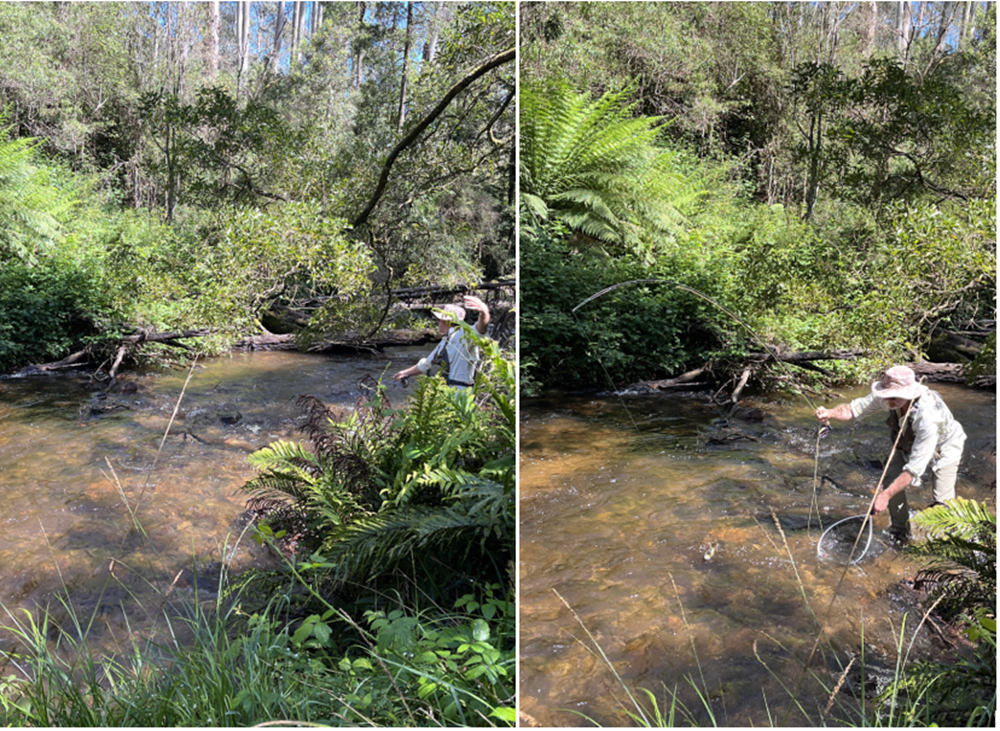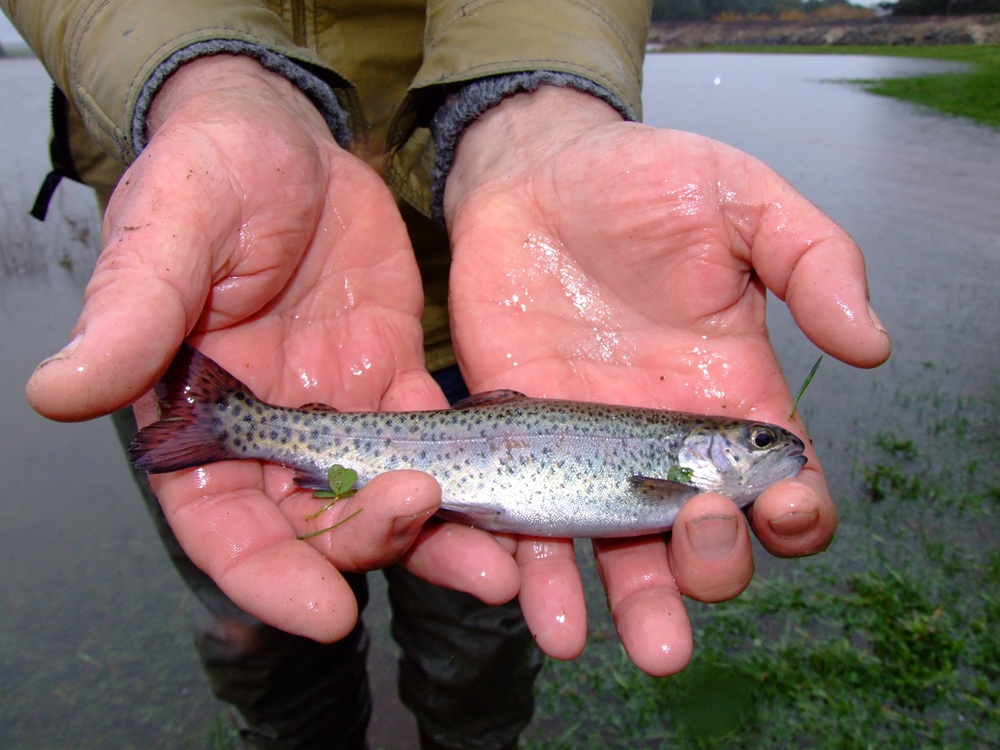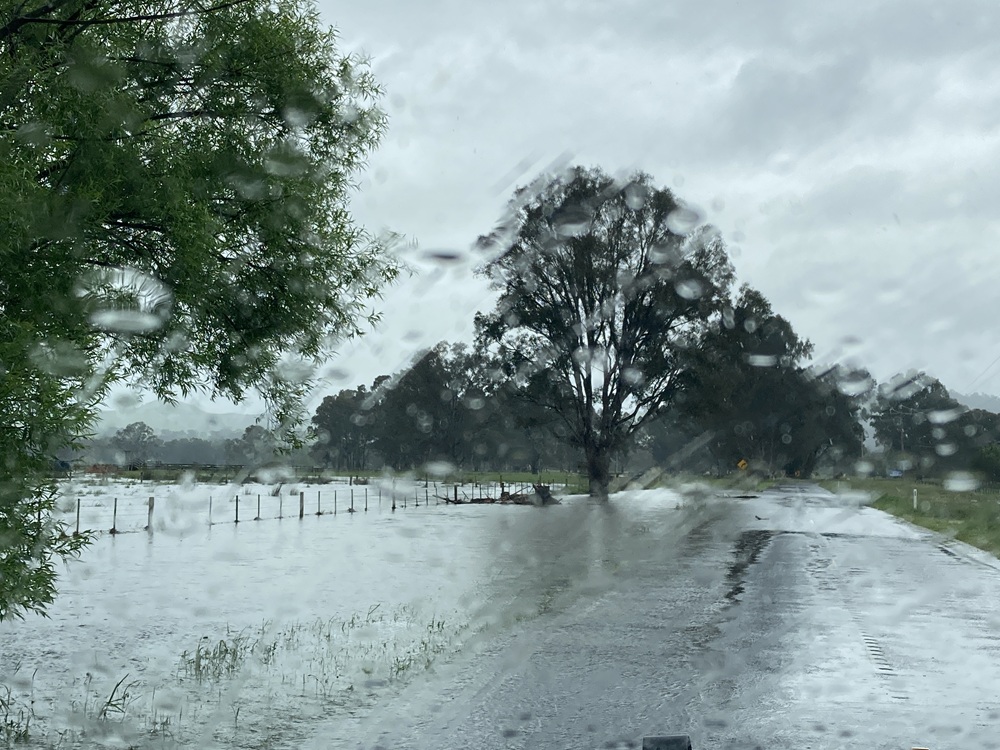
In contrast to many reports in early season 2024, the fundamentals looked good for rivers like the Goulburn... and so, it turned out, was the fishing more often than not.
At the start of Victoria’s stream trout season in September 2024, the word soon spread about the supposedly dire state of the fishing. As so often happens with social media, there was something of a pile on, as an increasing number of anglers (including some who should have known better) fell over each other to proclaim the death of the 2024/25 trout season before it had barely begun.
Since Noah stepped off the Ark, fishing reports have been one of the most popular forms of fishing media. We all love the shortcut of a recent report: the location, what the fish were doing, and what worked best. And of course nowadays, we don’t have to wait for the stone tablet to arrive by donkey. Instead, there’s the instant fix of the internet. Type what you want to know into a search engine, ask Siri, or even sit back and let the algorithms send you the information (disinformation?) which AI selects for you.
Sound too good to be true? Well of course it is. But you wouldn’t know it reading many of the online responses, where a total stranger’s opinion is treated with the same reverence as that of an established, reliable source.
The wrong intelligence?
Trout season 2024/25 was a good case study of what can go wrong on the information trail – and arguably a good case study of the human condition in general! People made decisions about the whole upcoming season, at a time of year (September) when the action is usually subdued by cold temperatures anyway. Then, having prematurely decided the fishing was going to be tough, they fished with less care and conviction, less often, and with less willingness to explore. A vicious circle… but not enough to stop them telling anyone who’d listen how bad the fishing was, thus perpetuating the negative vibe. I guess for some, it was perversely comforting to blame cormorants, or water levels, or angling pressure, or other factors beyond their control, for failure.
On the flip side were the anglers having success, but who, under the circumstances, were sometimes reluctant to shout about it.
A third issue in season 2024/25, was how nuance (and this afflicts the modern information age in general) seemed to have gone missing. We were frequently told the fishing was terrible, or occasionally great, but rarely somewhere in between. Perhaps there aren’t enough ‘likes’ available for reports which say, ‘Not as good as last season, but still worthwhile.’
In case all the above sounds judgemental, let me assure you I love a good tipoff as much as the next guy! A report from a reliable source, whether that's a trusted mate, fly shop, or a proven online source, is gold. It’s just that I recognise the rarity of such reports compared to the barrage of more dodgy information. And even with access to quality intel (and the experience to recognise it when I see it) at any given moment, I know there will be good fishing out there somewhere which is escaping general attention, including mine. That's despite the supposed omnipotence of the internet.
An alternative approach
Instead of planning your trips solely around fishing reports, there’s another option. That option is to make a cool-headed assessment of what I think of as the fundamentals: the many environmental bits and pieces which can potentially make or break a day on the water.
Incidentally, this requires us to leave aside for the moment actual fishing techniques. While these are of course very important in their own right, for now we’re more concerned about the presence (or absence!) of our target species, the water conditions we’re dealing with (both recently and currently), and any other variables which are likely to impact fish behaviour, such as predator pressure, or competition for food.
Fish stocks
My starting point for any trip is, what are the current stocks of my target species likely to be? This in turn comes down to inputs to the fishery – stocking, natural recruitment/ migration, or both; and outputs – mortality and migration being the main ones.
Depending upon where you are thinking of going, stocking input is relatively easy to assess. In Victoria, the Victorian Fishery Authority’s Fish Stocking Database is an excellent source of information: I mainly use the Search by Water only - VFA function. New South Wales and Tasmania also have stocking databases.
When assessing stocking history, there are some things to think about. Size at stocking can have a major impact on how many fish survive to catchable size. For example, many salmonid species are relatively well-suited to ‘growing on’ in the hatchery, although it’s still an expense some managers would prefer to avoid. Very small trout, which have required little husbandry since hatching, and are well-suited to transporting from hatchery to destination, provide a cheaper way for fishery managers to claim impressive stocking numbers. However, in lakes especially, really small ‘stockies’ are easy prey for larger predatory fish, especially redfin.
Trout stocked at over 50 grams stand a better chance of avoiding redfin predation than smaller fish.
So, although the equation is complex, for lakes with a redfin population (which is the majority in Victoria and NSW, and some in Tasmania) I’m ideally looking for salmonids stocked at over 50 grams to be really confident of a decent ‘cohort’ making it through to providing good fishing. Also, given that salmonids are relatively short-lived, I’m most interested in stocking data going back no further than 3-4 years.
At the other end of the scale, really big ‘stockies’ like ex brood stock, which may weigh a few kilograms each, have, for various reasons, a shorter life expectancy once in the wild. While they can provide a quick fishing ‘hit’, not many survive to the following season.
For most native species such as cod, golden perch, bass and estuary perch, on-growing is difficult, so they’re usually stocked small. Therefore, unlike for trout and salmon, there’s usually not much point in searching the databases for stockings of larger fish. In any case, the sheer number of natives stocked appears to offset what’s probably a high mortality of newly-released fish.
The other interesting point about natives compared to salmonids, is how generally slow-growing and long-lived they are. Fish like estuary perch and bass can take many years to grow to catchable size. On the other hand, natives can live for decades, so when looking at the data, even stocking from many years ago can be relevant.
When it comes to natural recruitment, it’s more challenging to assess its success or otherwise. In the case of trout, careful observation can offer clues. For example, during late summer/ autumn in 2025, I noticed lots of ‘young of the year’ trout: fish successfully spawned the previous winter/ spring and generally too small to target or catch. After a 2024/25 season when catchable-size trout were often less abundant than over the previous couple of seasons, these plentiful ‘littlies’ were a good sign for the future. Unlike many natives, trout can grow from finger-sized to catchable in months, not years – especially if there are fewer large trout to compete with.

Last autumn's 'young of the year' are now (early spring) well worth catching.
Assessing recruitment of natives is more difficult. Sometimes, relatively recent fisheries research such as VFA’s Native Fish Report Card Program can give useful insights into particular waters.
Measuring losses
Along with fish going into a system – whether through stocking or natural recruitment – we also have to consider potential losses to make a guesstimate of a water’s current fish stocks. Therefore, it’s useful to know what environmental conditions have been like over the last few years. Has anything occurred which might have killed a lot (or even all) of the fish? Catastrophic events like a water drying up, or blackwater (or similar deoxygenation) can basically remove all the target fish. We must then rely on wild fish reestablishing from refuge populations, or migration, or restocking from hatcheries, or all three.
And yep, once again, the equation is complex, and nuance can be king. (Sorry, but if you want black & white, you’ve chosen the wrong sport.) Drying lakes or streams can often be identified by searching water storage or river flow databases – ask Siri or one of her AI mates for the relevant website. (Turns out they can be useful if employed correctly!)
Recent water quality issues, however, aren’t as obvious to identify; although the websites or Facebook pages of catchment management authorities, water authorities and fisheries agencies are a good place to look.
After a major mortality event, trout are often the quickest to bounce back. As a fast-growing species, restocking can produce worthwhile fishing in less than a year. One classic example was Vic Fisheries' drought recovery stockings once drought-decimated waters refilled in 2010. Wild stocks in streams are at least as capable – migration and natural recruitment following the Black Summer fires in 2019/2020 saw numerous hard-hit creeks and rivers coming back as options again within months.
With natives, slower growth rates can slow recovery after disaster. On the other hand, migration can do a remarkable job, with species like bass, bream and estuary perch able to travel along the coast between systems. Inland, species such as golden perch and Murray cod can migrate huge distances under high flow conditions, assuming there’s free passage, so to speak, around manmade barriers.
Still, the bottom line for all species is, if a water has suffered a major environmental setback, you want to know about it and avoid fishing there – at least in the short term.
Predator pressure is another fundamental I need to factor into my fishing plans. Cormorant plagues are a recent example. The cormorant ‘fundamental’ didn’t stop me going fishing, but it certainly influenced where I went, and under what water conditions. Again, although the equation wasn’t binary, on a large scale, I was looking for waters with plenty of cover for fish, and/ or conditions more difficult for cormorants to hunt in, such as sustained swift flows.

During the 2024 cormorant plague, we found the fishing was much better if we focused on water where these birds would struggle to hunt easily.
In terms of angler pressure, if possible, I avoid clashes with club competitions, or known busy periods like public holidays or Easter. It’s not so much that such occasions remove all the fish I want to catch. It’s more about the short-term predator pressure response of the fish, and likely limitations on physical fishing space. If I am going to fish at such times, I’ll plan on visiting very large rivers or lakes where the pressure is likely to be well spread out, or I head to remote or lesser-known waters.
Closer to the trip
Within a few days of heading out, I’ll start to consider short-term local fundamentals. As just one example, on the big tailwaters, I dislike an artificial early or late season flood flow… although mid-season, these exact events can create amazing edge and backwater fishing. There’s that pesky nuance again!
Surprisingly, even floods can be a positive fundamental sometimes. However on this scale on the Rubicon River, where the floodwater has spread hundreds of metres from the regular river channel, they're best avoided.
Meanwhile, in October in central Victoria, the first forecast for a mild, cloudy day, might indicate the perfect time to check out the dun hatch on that lesser-known lake which social media (and most flyfishers) seem to have temporarily forgotten about. And while hot, windy summer weather might be terrible for a shallow lowland trout lake, it might be ideal for some alpine lakes and streams.
The list of these ‘short-term’ fundamentals is endless. The trick is to match the right fundamentals to your chosen destination. Don’t head to Wendouree on a 40C day just because you saw on your socials a few weeks ago that it was fishing well.
The best laid plans…
Perhaps oddly, NOT catching isn’t a reliable ‘fundamental’ – at least in small samples. All fish species are capable of being hard to catch at times. Natives are notorious for this, but trout can suffer lockjaw as well. Sometimes there’s an obvious reason, but at other times, even seasoned anglers can be baffled by those few dead hours, despite all the fundamentals seemingly lining up nicely.
I could write volumes on these rare but still annoying occasions when the fish should be biting, but they’re not. In practical terms though, all I can offer is to accept that these aberrations are part of the deal in flyfishing. Push through, and if the fundamentals stack up, then before long, so will the fish.
Finally, to reiterate, one advantage of being aware of the fundamentals - and an advantage which can make all the research gratifyingly worthwhile - is they can put you on a great spot, at a great time... before anyone else knows about it. Not a bad reward for effort!













